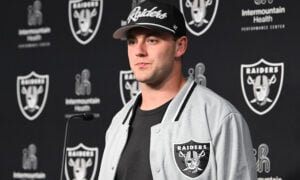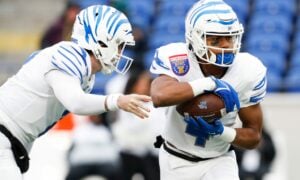The Dynasty Doctor: Arian Foster’s Surgery

Editor’s Note: Injuries are a huge part of winning and losing each year in fantasy leagues. Staying abreast of the injury situations is key as knowing what to expect from your players health-wise in the short term can help you make educated decisions in managing your team. Lucky for us, we have a Doctor in the house. Dr. Scott Peak is an ABPN board certified neurologist and neuro-oncologist. He is also a dynasty football addict and huge friend of Dynasty League Football. He’s excited to lend his expertise in medicine with hopes he may help the DLF Team and its followers better understand medical conditions and injuries that may impact NFL players and dynasty football owners.
Arian Foster sustained a groin injury last week and underwent surgery for it. Not surprisingly, this injury set off a firestorm of reports, debate and speculation that had Foster out as long as six months. We will take a closer look at this latest ailment and provide our thoughts on how this might impact his value in dynasty formats.
The injury has been described in sordid detail as “muscle tearing off bone” to a “sports hernia.” Not surprisingly, when reports of muscle tearing off bone are broadcast across the world, dynasty owners of Foster get anxious. In reality, both descriptors go together. I reviewed an article written by Dr. William Meyers (see reference below) on sports hernias, and the first thing that struck me is how the injury is often misconstrued.
Before we dive deep into the detail of this injury, we should discuss anatomy of the groin and pelvis. Check out this link on AAOS.
[am4show have=’g1;’ guest_error=’sub_message’ user_error=’sub_message’ ]
Now, the most important point to understand is, a sports hernia is NOT a hernia at all, at least not in the traditional sense. Most people think of hernias as a painful bulge in the groin region or near the belly button (umbilicus) that results from a weakening of the abdominal wall, leading to intestines bulging through. This can be a serious problem, especially if bowels are strangulated by the opening as it slips through the abdominal wall, visible as a bulge under the skin. These hernias are referred to as “umbilical” or “inguinal,” depending on where they are located.
A sports hernia involves tearing of soft tissue in the groin region and this can be muscles, tendons or ligaments. Hence, reports of “muscle tearing from bone” were probably right, but resulted in a lot of undue angst for those who read it. While traditional inguinal hernias can occur, it is actually not commonly associated with a sports hernia. Most sports hernias don’t have associated inguinal hernias, but can result in groin pain, mainly from tearing of soft tissue in this region. These injuries can present as a chronic discomfort (such as adductor tendinopathy) and this can increase risk for future injuries. It is interesting to note Foster has a history of groin injuries and sports hernias are thought to be in the category of overuse injuries. Whether or not he had a chronic tendinopathy is uncertain, but certainly a plausible contributor to his current dilemma.
There are several adductor muscles in the hip, including the adductor longus, adductor brevis, adductor magnus, pectineus and gracilis. Most have origins on the pubic bone and attach to the femur or tibia (gracilis). When these muscles contract, they will pull thighs inward and this is referred to as ‘adduction.’ The end result would look like a soldier standing guard at Buckingham Palace, legs straight and touching each other.
A sports hernia results with eccentric force generated in these muscles. Eccentric force occurs as athletes are cutting, the leg is moved outward (abduction), and there is simultaneous contraction of the adductors. Force generated in both directions puts too much stress on tendons, and a tear can occur. Overuse can increase risk of injury, as small tears that build up over many years can weaken tendons, leading to a larger tear with repeated force applied to this area.
I’m not an orthopedic surgeon, but I’ll do my best to translate findings in the article written by Dr. Meyers. Sports hernias can result when muscles in the groin are weakened by injury to tendons, while other muscles compensate, becoming stronger, or tighter. It’s important to not only re-attach/repair torn tendons, but also to make sure other muscles that are too tight are loosened up a bit, to return this region as close to normal anatomic function as possible. In reality, the operation is more involved than this description, but it gives you an idea of how the surgeon tries to repair this injury.
There have been advances in surgical techniques and rehabilitation protocols for sports hernias. Return to play, as per Dr. Meyers, is 95% or higher, with most returning to their previous level of performance. A small number of patients required re-operation. Dr. Meyers describes different rehabilitation protocols, including three and six week protocols, designed to return an athlete to play as fast as possible, but this also depends on the severity of injury. Most athletes were able to return to play “well before three months.”
My best guess is that initial reports of a six-month recovery were more of a manifestation of information flying out fast and furious. If complications arise with recovery, it’s possible Foster may take longer to recover. Still, NFL athletes have the best surgical and rehabilitation teams, and barring something unforeseen, it is reasonable to estimate Foster could return in a four-to-six week time frame, as has been noted in recent reports. There is a risk that it could stretch out to three months, if complications in recovery arise, but hopefully that won’t be the case.
Foster sustained this injury while practicing in training camp, so he is not eligible for PUP. He could be placed on Injured Reserved (IR designation to return). If that is the case, he would miss the first eight games (he could be activated on week eight at the earliest) and the Texans would need to decide whether to place him on the active roster no later than week nine (21 days after Foster returns to practice). Of course, Foster could end up on IR with no designation to return, ending his season, but at this point that seems unlikely. It’s also possible Foster could avoid IR altogether and that would be a great sign for his owners. Remember, per Dr. Meyers’ article, there are three-week rehabilitation protocols, so it’s entirely possible the Texans may elect not to place him on IR at all, if they believe he could return sooner than week eight.
How should owners approach this situation? It seems likely Foster will return to play this season. I will be greatly interested to see if Foster gets placed on IR with return designation or not, as this will determine how confident the Texans are he will return before week eight (again, the earliest possible return to play with IR designation to return). For re-draft owners or dynasty contenders, it might be worthwhile to make a move and acquire Foster at a discount now. There is significant risk with Foster staying healthy in the future, given his track record for injuries in the recent years, so buyer beware applies. Foster is a unique individual and I don’t think he will be praying for a hasty recovery anytime soon. He is also 28 years old, but doesn’t have as much mileage on him compared to other players of the same age (Foster has 1,618 touches versus LeSean McCoy’s 1,763 touches over six seasons). Marshawn Lynch has 2,272 touches over eight seasons. Lynch and McCoy have managed to stay healthier than Foster, so that must be taken into account. Clearly, a rebuilding dynasty team should have no interest in acquiring Foster. I think the best time to sell Foster will be at his return when contenders are in the thick of the race and his value should spike at that time. Selling Foster now would likely bring back significantly less value than remaining patient and waiting for his return this season.
References
Meyers WC, McKechnie A PT, Philippon MJ, et al. Experience With “Sports Hernia” Spanning Two Decades. Ann Surg 2008;248:656-665.
[/am4show]
- Dynasty Capsule: Carolina Panthers - February 3, 2017
- The Dynasty Doctor: CJ Anderson - January 25, 2017
- The Dynasty Doctor: Week 15 - December 20, 2016


































































